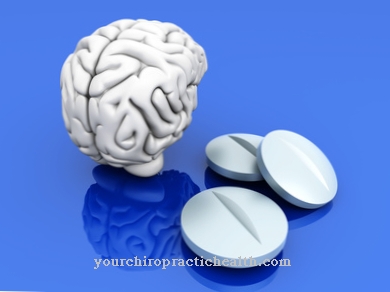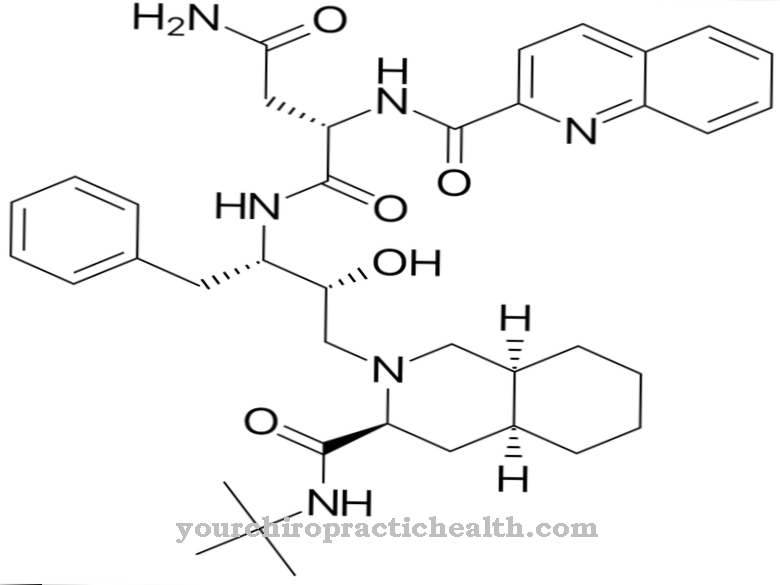Pyridostigmine is an acetylcholinesterase inhibitor and is used to treat myasthenia gravis (muscle weakness). Pyridostigmine is also used for urinary behavior and intestinal paralysis as a result of reduced tension in the muscles. Pharmacologically, it is applied as a bromide salt in the form of tablets.
What is pyridostigmine?

Pyridostigmine As a medicinal product, it belongs to the group of indirect parasympathomimetics. It thus indirectly activates the acetylcholine activity on the parasympathetic receptors by inhibiting the enzyme acetylcholinesterase.
The active ingredient is a quaternary amine complex that is present in drugs as a bromide. In undissolved form, pyridostigmine bromide is a white, crystalline powder. It dissolves very well in water. If necessary, the drug is administered in the form of tablets.
Pyridostigmine bromide cannot cross the blood-brain barrier because it is not lipophilic due to its salt-like structure. Its plasma half-life is around 1.5 hours. After use, the drug is partly metabolized and partly excreted unchanged via the kidneys (via the urine).
Pharmacological effect
Pyridostigmine acts indirectly by inhibiting the enzyme acetylcholinesterase. This enzyme is responsible for breaking down the neurotransmitter acetylcholine in the synaptic gap to acetate and choline.
The inhibition of acetylcholinesterase in turn causes an increase in the acetylcholine concentration at the motor endplate. The acetylcholine receptors there are cation channels, which stimulate the muscles through the cation currents triggered by acetylcholine. This increases the tone (tension) of certain muscles, increasing the likelihood of muscle contraction. In general, the activity of the parasympathetic nervous system, which is responsible for the physical processes in the resting phase, also increases.
The parasympathetic nervous system controls the muscle tone and the metabolic processes including the bowel and bladder functions. In autoimmune myasthenia gravis, disorders of the receptors for acetylcholine occur, so that sufficient muscle contractions can only be caused by a higher acetylcholine concentration.
The bladder or intestinal muscles are also stimulated. This property also makes pyridostigmine a good active ingredient for treating paralysis of the bladder or intestinal muscles. The increase in the acetylcholine concentration also causes antagonistic muscle relaxants to be displaced by the acetylcholine receptors, which are used as drugs to calm muscles. If necessary, pyridostigmine is used to reverse the effects of these drugs.
Medical application & use
Pyridostigmine is mainly used to treat myasthenia gravis disease. Depending on the severity of the disease, the doctor must determine the individual dose of the drug.
Treatment begins with pyridostigmine alone. However, if there is no improvement, treatment in combination with guanine can be continued. The drug is applied in the form of tablets. Due to the wide range of possible side effects and the possibilities of interaction with various other drugs, treatment should always take place under medical supervision.
The use together with other parasympathomimetic active ingredients leads to an intensification of the effect. The effect of the drugs for muscle relaxation is canceled. In this context, pyridostigmine may have to be used in the event of an overdose with muscle relaxants or other problems occurring. Another area of application is in cases of urinary retention or intestinal atony (intestinal paralysis). Here, however, it must be ensured that pyridostigmine is absolutely contraindicated in the case of a mechanical obstruction of the intestine or a mechanically caused urination disorder.
In this case, stimulating the bladder or intestinal muscles can lead to serious complications. In the "Second Gulf War 1991", pyridostigmine was also used prophylactically against poisoning by chemical warfare agents based on cholinesterase inhibitors.
You can find your medication here
➔ Medicines for muscle weaknessRisks & side effects
The use of Pyridostigmine As with all drugs, there is a risk of side effects that can occur but do not have to occur.
As the activity of the parasympathetic nervous system is increased, typical symptoms such as diarrhea, vomiting, abdominal cramps, increased salivation, increased mucus formation in the bronchi, bradycardia, drop in blood pressure and adjustment disorders of the eye result from this to varying degrees. Since bronchial constriction can also occur, application to patients with obstructive airway diseases is contraindicated.
The same applies to mechanical bowel and bladder obstruction. An overdose of the drug can weaken the muscles of the airways as a result of a cholinergic crisis. Other side effects are increased perspiration and an increased urge to urinate. Pyridostigmine should not be used in pregnancy or breastfeeding.



























